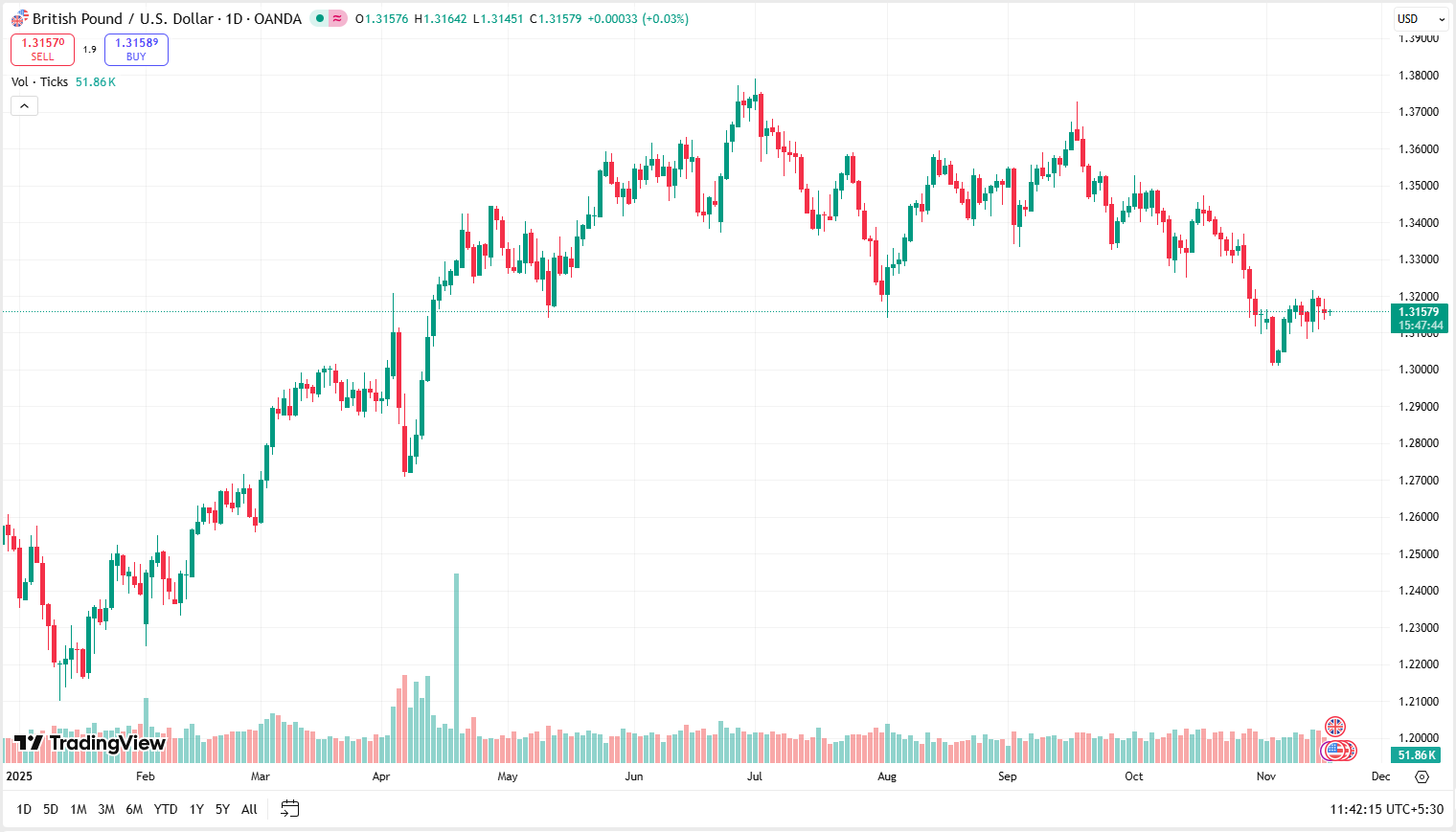GBP/USD Struggles Amid Fiscal Uncertainty And Data

GBP/USD remained under pressure, trading near 1.3150 in Tuesday’s early trading hours as the pair struggled to extend last week’s modest rebound. The pound is believed to be defensive following three straight muted sessions, with the pricing movement showing a continued lack of confidence in the fiscal outlook of the UK and dwindling domestic economic impetus. The failure to maintain gains above the 1.3200 area shows the absence of a bullish belief, which puts the near-term bias marginally against the downside.
Market reports point out that the pound sentiment worsened as the UK Chancellor Rachel Reeves reversed former planned income-tax increases, something that has left people questioning the longer-term government fiscal direction even when the Office of Budget Responsibility reduces its deficit forecasts. Although there is still an option to increase revenues by adjusting the threshold and reforming salary-sacrifices, markets see the solution as biased towards a smaller fiscal package, restricting assistance to the currency. Meanwhile, the weaker macro performance of the UK such as the marginal Q3 growth and the shrinking in the September GDP only serves to strengthen the anticipation of a Bank of England (BoE) rate cut in December.
Market commentators note that the US dollar, however, is trading in a relatively stable manner with investors setting themselves up ahead of a batch of US economic reports once the government reopens. Though the expectations of a rate cut by the Federal Reserve (Fed) in December have been relieved, its probability decreased to 62% to about 43%, the greenback is still getting short-term support due to a dovish price. But remarks by Fed Governor Christopher Waller, who indicated he would favour a December rate cut as labour-market dynamics deteriorate, lay downward risks on the US dollar should incoming statistics reveal a continuation of cooling.
Analysts suggest that the US data this week will be especially important in determining the short-term direction in GBP/USD, especially employment indicators and activity surveys. The US labour or manufacturing performance may become gentler, however, any evidence to this effect might restrain dollar strength, although unresolved UK growth concerns and increasing BoE easing bets may still restrict pound gains, maintaining medium-term risks biased against the pair. Overall, the bias remains tilted slightly lower for the GBP/USD exchange rate.

EUR/USD Steadies as Dollar Weakens Ahead Data
EUR/USD traded quietly near 1.1600 in Tuesday’s Asian session, consolidating after pulling back from a more than two-week high at 1.1656. It is believed that the two-minute stand of the US dollar may indicate that the currency is enjoying a momentary reprieve, as the traders are now apprehensive in the face of some key US labour market statistics. Volatility has subsided, which means that EUR/USD is trading in a narrow intraday range as it awaits new catalysts, which would trigger a more convincing directional trend.
Market reports indicate that the US Dollar Index (DXY) has gone soft at 99.45 following a rebound lower early on in the week due to diminished prospects of a further Fed rate cut this year. The likelihood of a 25-basis-point cut in December, according to CME FedWatch tool, has receded, and strengthens a more balanced view on US monetary policy. Nonetheless, future US data, such as upcoming September Nonfarm Payrolls, should give better indications about the momentum in the labour market. Any sign of loosening the labor market or weaker wage gains could once again put downside pressure on the dollar, which will temporarily support EUR/USD.
Market watchers note that in the Eurozone, European central bank (ECB) officials are still hinting on the need to maintain the rates at their current level due to a balance of risks towards inflation and growth. This conservative approach to policy restricts the potential of the Euro, but it also assists in mitigating short-term volatility. Technically, the pair encountered continuing selling interest around a downward trendline drawn on the September 22 top at 1.1818. EUR/USD has been pulled back to the 20-day EMA which is now around 1.1580 which shows a drift and not a reversal of the trend.
Analysts suggest the momentum indicators are neutral as the 14-day RSI is stuck at 40-60. Strong support is at the low of October 9, 1.1542 and then the level of August, 1.1400. Any break above 1.1656 would allow entry to 1.1700 and 1.1728 however there are still medium-term risks in case future US data fails to impress and wider economic risk concerns the recovery of the pair. In short, the sentiment is mildly neutral-to-cautious for the EUR/USD exchange rate.

EUR/GBP Steadies as Shifting Rate Expectations Loom
EUR/GBP traded broadly steady near 0.8810 in Tuesday’s early European session, with the cross consolidating after last week’s upward drift. The price action is believed to be within a small range as the markets consider the effects of the recent UK macroeconomic softness against the stabilising policy background in the Eurozone. This low tone indicates the cautiousness before this week’s key data catalysts that traders believe may give the pair more direction in the short term.
Market reports indicate that the pound is still struggling to gain momentum after the recent UK GDP report that was lower than projected and boosted the speculation that the BoE could provide a rate cut as early as December. Market pricing now suggests that Bank Rate is likely to be reduced to 3.75, since the poor performance of the labour market, which has been highlighted by the increase in unemployment to the highest level since early 2021 and the moderation in wage growth imply the reduction in the domestic pressures of inflation. This trend has continued to put pressure on the down of the GBP, which has been supportive to the pair.
Market observers note that next on the agenda are the upcoming UK CPI and PPI prints, which average inflation is projected to recover to 3.6% YoY and core CPI will be 3.4% YoY. The pound might be temporarily boosted by any positive surprise to cool unfriendly rate-cut anticipations. But as the wider economic wind slows the response can be temporary. Besides, another uncertainty source will be the following Autumn Budget, especially in case fiscal announcements shift the growth or inflation expectations on a medium-term basis.
Analysts indicate that the pair is also expected to be affected by external factors, especially future economic releases in the US. Weak US data has just strained the global yields down, which, in turn, indirectly pressed the pound, as it strengthened the flows of risk aversion and supported more stable currencies. Although the given background provides a short-term support on EUR/GBP, the long-term view is carefully held with the policy divergence and the incoming data expected to rule the direction by year-end. As a conclusion, sentiment leans mildly positive for the EUR/GBP exchange rate.

NZD/USD Slips as Policy Divergence Weighs
The NZD/USD edged lower and traded around 0.5655 in Tuesday’s Asian session, extending its recent corrective pullback as sentiment surrounding the New Zealand dollar remains fragile. It is believed that the price action indicates that the two are consolidating around multi-week lows, and that intraday rebounds are limited by incessant macroeconomic headwinds. A small rise in risk appetite after the US vote to cancel tariffs on major New Zealand exports is not enough to boost the kiwi, indicating a market that is still obsessed with domestic policy divergence and crumbling growth dynamics.
The market reports indicate that the New Zealand dollar is mostly held down by the anticipation of further monetary relaxation by the Reserve Bank of New Zealand (RBNZ). Following the reduction in the Official Cash Rate to 2.5% in October in response to a steeper-than-anticipated 0.9% contraction in the GDP in Q2 2025, market consensus is that the November meeting will see another reduction of 25 bps. The active easing cycle by RBNZ during the year 2025 continues to weaken yield support in kiwi leaving rally shallow and vulnerable. The tariff rollback, although pro-trade in its approach, has not as yet been able to counter the pessimistic policy approach.
Market observers note that in the US, hawkish remarks by federal officials provided intermittent support to the US dollar but the overall expectation is pegged on the data coming in. Traders are currently looking at this week’s US releases, particularly the September Nonfarm Payrolls (NFP). The lower than expected readings in recent labour and demand reports have added some downside risk to the dollar but the focus on keeping the policy restrictive by the Fed officials is still constraining the ability of the US dollar to sell.
Analysts suggest that the two could be moderately supported in the short-term by ameliorating US New Zealand trading relationships although the medium term would remain skewed at the lower end. The increasing policy difference between the Fed and the RBNZ unless US data responds meaningfully to the contrary implies further upward constraints to the two, with risks remaining skewed toward additional challenges of new lows. Lastly, the outlook remains tilted to the downside for the NZD/USD exchange rate.



 English
English 




































































































